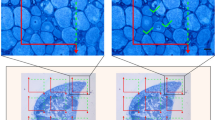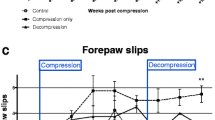Abstract
The treatment of radicular pain is mainly empirical because there are only few experimental studies dealing with morphological changes during compression radiculopathy. The goal of the study was to investigate changes in the morphology of myelinated axons during spinal root compression and the influence of decompression in a new rat model. The number of myelinated axons and their diameter were measured at 1, 2, 5, and 8 weeks during compression of the dorsal spinal root. The same approach was applied for 1-week compression followed by decompression for 1 or 2 weeks and compression for 5 weeks followed by 3-week decompression. A decrease in the number of myelinated axons (particularly those of large diameters) occurred after compression for 1 week. Continued compression for up to 8 weeks resulted in centripetal increase in the number of myelinated axons and the persistence of a small fraction of large myelinated axons at the site of compression. After that time, a decreased number of axons and a reduced fraction of large myelinated axons occurred again. Decompression after 1-week compression caused a rapid increase in the number of both small and large myelinated axons within the spinal root including the site of compression. A small fraction of regenerated axons was found after 5-week compression followed by 3-week decompression. Finally, we investigated the time course of the temporary increase in the number of regenerated myelinated axons during dorsal root compression for up to 8 weeks. The efficacy of decompression was superior when applied one week after compression or after regress of the acute phase of aseptic inflammation associated with fragility of spinal root. The results of the study verify the need for early surgical decompression to prevent irreversible damage of the spinal roots.








Similar content being viewed by others
References
Avellino AM, Hart D, Dailey AT, MacKinnon M, Ellegala D, Kliot M (1995) Differential macrophage responses in the peripheral and central nervous system during wallerian degeneration of axons. Exp Neurol 136:183–198
Bruck W (1997) The role of macrophages in Wallerian degeneration. Brain Pathol 7:741–752
Cornefjord M, Sato K, Olmarker K, Rydevik B, Nordborg C (1997) A model for chronic nerve root compression studies. Presentation of a porcine model for controlled, slow-onset compression with analyses of anatomic aspects, compression onset rate, and morphologic and neurophysiologic effects. Spine 22:946–957
Fager CA (1994) Observations of spontaneous recovery form intervertebral disc herniation. Surg Neurol 42:282–286
Frymoyer J (1991) Epidemiology of spinal diseases. In: Mayer T, Mooney V, Gatchel RJ (eds) Contemporary conservative care for painful spinal disorders. Lea and Febiger, Philadelphia, pp 10–23
Habtemariam A, Gronblad M, Virri J, Seitsalo S, Karaharju E (1998) A comparative immunohistochemical study of inflammatory cells in acute-stage and chronic-stage disc herniations. Spine 23:2159–2165
Hou SX, Tang JG, Chen HS, Chen J (2003) Chronic inflammation and compression of the dorsal root contribute to sciatica induced by the intervertebral disc herniation in rats. Pain 105:255–264
Hu SJ, Xing JL (1998) An experimental model for chronic compression of dorsal root ganglion produced by intervertebral foramen stenosis in the rat. Pain 77:15–23
Kawakami M, Weinstein JN, Chatani K, Spratt KF, Meller ST, Gebhart GF (1994) Experimental lumbar radiculopathy. Behavioral and histologic changes in a model of radicular pain after spinal nerve root irritation with chromic gut ligatures in the rat. Spine 19:1795–1802
Kawakami M, Tamaki T, Weinstein JN, Hashizume H, Nishi H, Meller ST (1996) Pathomechanism of pain-related behavior produced by allografts of intervertebral disc in the rat. Spine 21:2101–2107
Kawakami M, Tamaki T, Hayashi N, Hashizume H, Nishi H (1998) Possible mechanism of painful radiculopathy in lumbar disc herniation. Clin Orthop Relat Res 351:241–251
Kawakami M (2005) Pathophysiology of radicular pain. Clin Calcium 15:377–382
Kobayashi S, Yoshizawa H, Yamada S (2004) Pathology of lumbar nerve root compression. Part 2: morphological and immunohistochemical changes of dorsal root ganglion. J Orthop Res 22:180–188
Novak Z, Krupa P, Zlatos J, Nadvornik P (2000) The function of the cerebrospinal fluid space and its expansion. Bratisl Lek Listy 101:594–597
Oblinger MM, Lasek RJ (1984) A conditioning lesion of the peripheral axons of dorsal root ganglion cells accelerates regeneration of only their peripheral axons. J Neurosci 4:1736–1744
Olmarker K, Holm S, Rosenqvist AL, Rydevik B (1991) Experimental nerve root compression. A model of acute, graded compression of the porcine cauda equina and an analysis of neural and vascular anatomy. Spine 16:61–69
Omarker K, Myers RR (1998) Pathogenesis of sciatic pain: role of herniated nucleus pulposus and deformation of spinal nerve root and dorsal root ganglion. Pain 78:99–105
Rothoerl RD, Woertgen C, Brawanski A (2002) When should conservative treatment for lumbar disc herniation be ceased and surgery considered? Neurosurg Rev 25:162–165
Suchomel P, Stastny F, Trojan S (1983) The effect of cortisol on intracranial pressure and asphyxic edema in the chick embryo. Bratisl Lek Listy 79:30–37
Tabo E, Jinks SL, Eisele JH Jr, Carstens E (1999) Behavioral manifestations of neuropathic pain and mechanical allodynia, and changes in spinal dorsal horn neurons, following L4–L6 dorsal root constriction in rats. Pain 80:503–520
Thomas PK, Berthold CH, Ochoa J (1993) Microscopic anatomy of the peripheral nervous system. Peripheral Neuropathy. W.B. Saunders Company, Philadelphia
Toh E, Mochida J (1997) Histologic analysis of the lumbosacral nerve roots after compression in young and aged rabbits. Spine 22:721–726
Yoshizawa H, Kobayashi S, Morita T (1995) Chronic nerve root compression. Pathophysiologic mechanism of nerve root dysfunction. Spine 20:397–407
Acknowledgments
This work was supported by grant GACR 309/03/1199 and MSM0021622404. We would like to thank Dana Kutejova for excellent technical support.
Author information
Authors and Affiliations
Corresponding author
Rights and permissions
About this article
Cite this article
Jancalek, R., Dubovy, P. An experimental animal model of spinal root compression syndrome: an analysis of morphological changes of myelinated axons during compression radiculopathy and after decompression. Exp Brain Res 179, 111–119 (2007). https://doi.org/10.1007/s00221-006-0771-5
Received:
Accepted:
Published:
Issue Date:
DOI: https://doi.org/10.1007/s00221-006-0771-5




